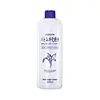What's inside
What's inside
 Key Ingredients
Key Ingredients

No key ingredients
 Benefits
Benefits

 Concerns
Concerns

No concerns
 Ingredients Side-by-side
Ingredients Side-by-side

Water
Skin ConditioningButylene Glycol
HumectantPentylene Glycol
Skin ConditioningPPG-10 Methyl Glucose Ether
Skin ConditioningDipropylene Glycol
HumectantDiglycerin
HumectantSodium Hyaluronate
HumectantHydrolyzed Hyaluronic Acid
HumectantSodium Acetylated Hyaluronate
HumectantHydroxypropyltrimonium Hyaluronate
Sodium Hyaluronate Crosspolymer
HumectantLactococcus/Hyaluronic Acid Ferment Filtrate
Hydrolyzed Sodium Hyaluronate
Skin ConditioningC12-13 Alkyl Glyceryl Hydrolyzed Hyaluronate
Aphanothece Sacrum Polysaccharide
AbsorbentHydroxyethyl Urea
HumectantPolyquaternium-51
Skin ConditioningHydrogenated Starch Hydrolysate
HumectantGlycosyl Trehalose
Emulsion StabilisingSorbitol
HumectantXylitylglucoside
HumectantAnhydroxylitol
HumectantIsopentyldiol
HumectantXylitol
HumectantCarbomer
Emulsion StabilisingXanthan Gum
EmulsifyingDisodium Succinate
MaskingPropanediol
SolventPotassium Hydroxide
BufferingSuccinic Acid
BufferingDisodium EDTA
Caprylhydroxamic Acid
Phenoxyethanol
PreservativeWater, Butylene Glycol, Pentylene Glycol, PPG-10 Methyl Glucose Ether, Dipropylene Glycol, Diglycerin, Sodium Hyaluronate, Hydrolyzed Hyaluronic Acid, Sodium Acetylated Hyaluronate, Hydroxypropyltrimonium Hyaluronate, Sodium Hyaluronate Crosspolymer, Lactococcus/Hyaluronic Acid Ferment Filtrate, Hydrolyzed Sodium Hyaluronate, C12-13 Alkyl Glyceryl Hydrolyzed Hyaluronate, Aphanothece Sacrum Polysaccharide, Hydroxyethyl Urea, Polyquaternium-51, Hydrogenated Starch Hydrolysate, Glycosyl Trehalose, Sorbitol, Xylitylglucoside, Anhydroxylitol, Isopentyldiol, Xylitol, Carbomer, Xanthan Gum, Disodium Succinate, Propanediol, Potassium Hydroxide, Succinic Acid, Disodium EDTA, Caprylhydroxamic Acid, Phenoxyethanol
 Reviews
Reviews

Alternatives
Ingredients Explained
These ingredients are found in both products.
Ingredients higher up in an ingredient list are typically present in a larger amount.
Butylene Glycol (or BG) is used within cosmetic products for a few different reasons:
Overall, Butylene Glycol is a safe and well-rounded ingredient that works well with other ingredients.
Though this ingredient works well with most skin types, some people with sensitive skin may experience a reaction such as allergic rashes, closed comedones, or itchiness.
Learn more about Butylene GlycolDipropylene Glycol is a synthetically created humectant, stabilizer, and solvent.
This ingredient helps:
Dipropylene glycol is technically an alcohol, but it belongs to the glycol family (often considered part of the ‘good’ alcohols). This means it is hydrating and gentle on skin unlike drying solvent alcohols like denatured alcohol.
As a masking agent, Dipropylene Glycol can be used to cover the smell of other ingredients. However, it does not have a scent.
Studies show Dipropylene Glycol is considered safe to use in skincare.
Learn more about Dipropylene GlycolWater. It's the most common cosmetic ingredient of all. You'll usually see it at the top of ingredient lists, meaning that it makes up the largest part of the product.
So why is it so popular? Water most often acts as a solvent - this means that it helps dissolve other ingredients into the formulation.
You'll also recognize water as that liquid we all need to stay alive. If you see this, drink a glass of water. Stay hydrated!
Learn more about Water